by Jean-Michel David
There are a few cards in the sequence that were especially influential in early in my tarot interests sending me scurrying through historical connections and developments. This is one of those, the other two being XVI and XXI. Not that other cards lack such interest, of course.
This card has numerous details worthy of careful attention and reflection, not least of which are the beings depicted on its periphery.
Let's first consider from whence the image derives and its context.
Boethius
We need go no further than Boethius's immensely influential early 6th century Consolation of Philosophy (1) to find the basis for the Mediaeval (and later) European pervasiveness of the image and allegory.
The whole text is image rich, and it is no wonder that it formed one of the most popular works in Mediaeval times and that it was translated in various vernacular languages (including English by both Chaucer and Elizabeth I, as well as in Old French and German). In Italy, it was highly influential in Dante's Divine Comedy. Llull, Boccaccio, Malory, as well as the works of Chaucer and of Shakespeare, and indeed the very imagery used on major Lumière ('Gothic') Cathedrals, all show direct evidence of his incredible importance and influence. Furthermore, the manner in which Aristotle came to be understood by the scholastics of subsequent years was in large part via Boethius – though in this case his other and earlier philosophical works.
The opening section of Book II of the Consolation of Philosophia is of principal import when it comes to Fortune herself:
'If I have diagnosed the cause and nature of your condition,
you are wasting away in pining and
longing for your former good fortune. [...] I know
the many disguises of that monster, Fortune [...].
If you are trying to stop her wheel from turning,
you are of all men the most obtuse. For if it once
begins to stop, it will no longer be the wheel of chance.
'With domineering hand she moves the turning wheel,
Like currents in a treacherous bay swept to and fro:
Her ruthless will has just deposed once fearful kings
While trustless still, from low she lifts a conquered head;
No cries of misery she hears, no tears she heeds.
But steely hearted laughs at groans her deeds have wrung.
Such is the game she plays, and so she tests her strength;
Of mighty power she makes parade when one short hour
Sees happiness from utter desolation grow.'
Here Boethius listens to Philosophia (c. 1460):
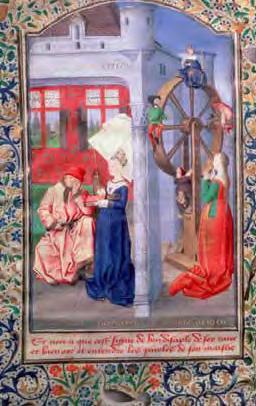
Such is his influence in the world of philosophy and of ideas that I personally rank him as one of the most influential European thinkers of all time. And the work for which he is best known remains readily conceptually accessible to readers from a wide variety of background (unlike, I would suggestas an example, many of the works of Aristotle).
To be sure, the concept of fortuna antedates Boethius (2). What he does, however, is raise her to a specific mental picture such that what becomes of great noteworthiness is not the figure of Fortuna herself, but of something he really brings afresh and anew: the wheel upon which we inevitably travel throughout our lives. In contrast, Fortuna was Tyche ('luck') in Ancient Greece, a concept at times overlaid with the workings of the three fates.
Looking at the image of the Wheel of Fortune adjacent which Boethius speaks (or listens) to Philosophia (cf above) shows well some of the various other aspects of tarot worthy of considersation: it draws us in to participate in the event, especially if we read his text at the same time. Also, the very words used, viz, "if it once begins to stop, it will no longer be the wheel of chance" (or, in the words of another and earlier translation: "if Fortune begin to stay still, she is no longer Fortune") brings our imagination to active participation. For it is Fortuna that is represented, and for that the wheel must move.
Yet, she is capricious and inconstant, unlike the'eternal' movement of the stars which can be forecast by their constancy. Whereas the celestial realm moves and is constant, here below Fortune may play and move with erratic fickleness (3). It is in combining these two concepts – that of the celestial and the earthly realms – that we arrive at some representations of the Wheel of Fortune, and indeed possible considerations of astrology, with the planetary movement providing clarity of direction, of season, of various cycles. The only 'cycle' that the Wheel provides is one where change must of necessity occur – echoing Heraclitus that everything is in a state of flux.
Inconstant and Capricious
This, for the Ancients, was very much one of the key factors in not being able to predict the future unless ordained by one of the gods. Either it was ordained and hence able to be communicated by the sibyls (or equivalent), or it was left to the vicissitudes of Fortuna.
And it is in part this that continues to play in modern tarot readings as divination and 'fortunetelling': in what manner is the wheel's movement sensible – in both this word's meaning as 'reasonable' and 'able to be sensed into'?
Instead of seeking to answer the question directly, let's sense into the actions of movement: to imagine oneself in the position of Fortuna (in the image below), moving the wheel as one wishes. Whether clockwise or anti-clockwise, a little in one direction and then in the other...
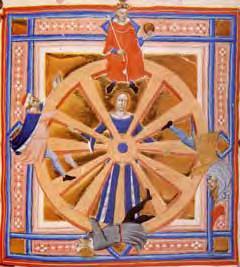
I am reminded here of a comment made by Bernard Lonergan in his Method in Theology (4), in which he states:
The symbol, then, has the power of recognizing
and expressing what logical discourse abhors: the
existence of logical tensions, incompatibilities,
conflicts, struggles,, destructions [...]
Noblet
Compared to the other Marseille-type decks, [TdM], the Jean Noblet shows some clarity of spokes, a detail that appears to have slowly eroded over time.This is evident if we compare, for example, the cards from a Visconti-type, the Noblet, a Dodal, and a Conver (see below).
If in the Visconti we still have the very traditional depiction of Fortuna actually included in the image (in her slightly less usual form as hoodwinked) and turning the wheel directly with her hands on the spokes, by the time of the 1650 Noblet, not only has she disappeared, but there is now the common wheel axle and handle and, instead of four figures around the wheel, only three remain.
These three figures also seem to lose detail over time. In the Noblet, they appear more like an ape or monkey-like figure descending, an ass-like figure ascending, and a human-like crowned figure atop. By the time of the Conver, the three are far more difficult to distinguish – yet still sufficiently clear if the symbolic meaning is known (to which we shall return shortly).
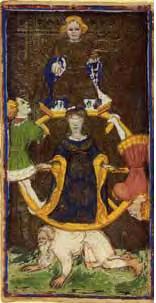
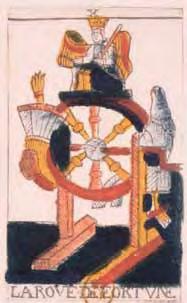
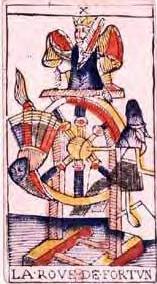
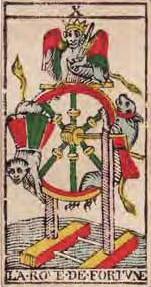
These animal-figurines are quite different to the more classical depictions showing, generally, all human beings in different parts of the wheel (though there are exceptions to which we shall also return).
The images I show above also have distinct differences of direction of rotation: the TdMs move counterclockwise (as judged by the orientation of the side figures, presuming, to be sure, that the head leads movement). In contrast, the Visconti and the other two previous images have the figures move clockwise – though, again, there is no universality of represented direction even in very early imagery, something that can be seen from the image in the below.
If we look at the centre of each wheel, what is striking in the TdMs is that the 'hub' is depicted as a representation of the world – or, to be more precise, the Earth, divided in the mediaeval three-fold division as also evident atop the sceptre of the Emperor or Empress (this is already beginning to be a detail that is lost in the 1760 Conver).
Of the three TdMs, only the Noblet shows the axle shafted to each supporting post: both the Dodal and the Conver seem to have forgotten the far side.Finally, the base on the Noblet has no 'cross-beams'connecting the two sides.
The 'obvious' meaning
If we consider for a while the more obvious allusion to Fortuna's Wheel, it shows the ups and downs to which humanity is inevitably subjected whilst on Earth – and this see-sawing both individuals as well as social groups, or indeed even nation-states.
At a general level, it applies to life's ebbs and flows that may even have seasonal regularity (such as the enjoyment of fresh berries). Indeed, for the community aware of its reliance on land and its produce, the Wheel turns with both regularity, yet remains fickle in terms of its recolte.
For most of us, these 'ups and downs' are perhaps more reminders of the joys of festival and youthful rides on a ferris wheel – its origin intimately connected to Fortuna's Wheel (here from the works of Bocaccio).
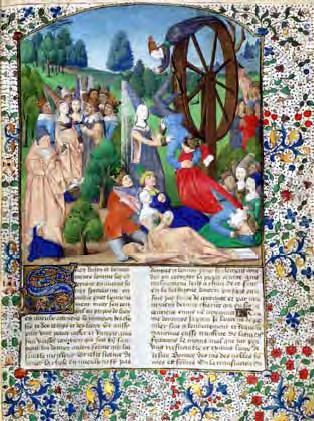
For some, the wheel has more extreme and lively reflections: on a personal note, as a child of a father who (at the time) made his living from professional gambling, the financial highs as well as the lows were vast, and were, to a child, an invisible cause of the various alterations in our access to everyday things. A week spent living in what could only be described as super-luxurious accommodation, being driven in a brand new limousine, would be followed by another in which we would resort to staying with grandparents out of apparent lack of alternative options. And his own life has continued to display this seeming fascination to experience the full rim of Fortuna's wheel: from wealth beyond the reach of most; to poverty that (in his case) cannot reasonably be accounted for; and back again to wealth.
Whether it be wealth, or power, or health, or happiness, or social position, or whatever, there remains, of course, another aspect to the situation: ie, our own particular way of meeting the trials and tribulations that we are served – for whether at the top of wheel or anywhere else on its periphery, trials it brings, and ways of meeting these are various.
Here, then, another early consideration may be worth noting upon which reflections shed further insight, for whatever is served by the wheel's movement also demands of us ways in which to embrace life's unfoldment.
The Wheel's Rim and Centre
Upon a wheel, the greatest movement is at the outer edge of the wheel – along its rim. At its centre, there is a 'stillness'.
By analogy, by striving to move towards the centre of the wheel, we may not fall as low, but neither be raised as high.
In the movement of the wheel (as attached to a wagon, for example), it is also strange, once we carefully consider it, that its centre moves 'as far' as its rim. Such became part of an old paradox named "Aristotle's Wheel" (though it originates in a later text). Consider this: a wheel is rolled for one revolution along the ground (the blue lower 'a' line in the image below), therefore, the centre moves across the orange upper 'c' line, and the inner circle would also make one revolution along the green middle 'b' line. All three lines are therefore of equal lengths.
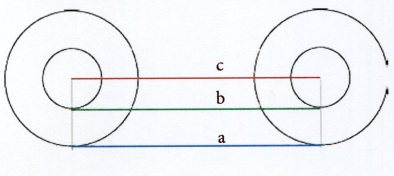
The paradox is that if the 'a' line (the larger rim unfurled once) is the same as the 'b' line (the smaller rim unfurled also only once), and again the same as the centre moving across, then the circumference of the smaller and larger rims are exactly the same – which we know not to be true.
In terms of the motions of a suspended wheel, as the one of Fortune, the paradox has similarities to considerations of the apparent conflict of the possibility of both foreknowledge and free-will, and thus similarly brings to mind this paradox that also occupied the thoughts of our forebears.
Astrological considerations
This consideration of the rotations of the inner and outer rims is also worth considering in light of the centre of the Wheel as depicting the Earth, and the outer the movement of the planetary bodies – that other great movement that, this time, as far greater stability, though, with the planets, also 'meander' across the otherwise apparently fixed stars (5).
Here, to be sure, it is not Fortuna, but an angelic being that turns the wheel – a wheel that nonetheless also has implications for the realms 'below':
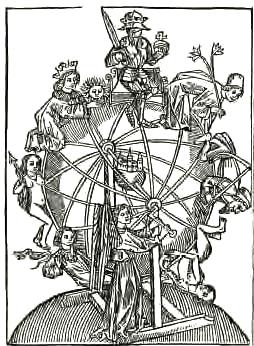
Again, the realm of the Earth is centrally depicted, and in this case, the seven traditional planets, with Mars on top, depict also the manner in which even in the heavens, rulership amongst the planets is not fixed, but moves.
The above image is one of the early ones that lead me to consider alternatives often not considered. Could the depictions be planetary?
Wheel of Life
Even without considering the vicissitudes of life, there is undoubtedly the inevitable movement of growth, peak, and demise that also accompanies one's life.
The Wheel of Fortune also asks us to be aware of
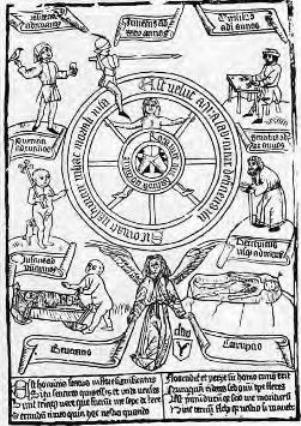
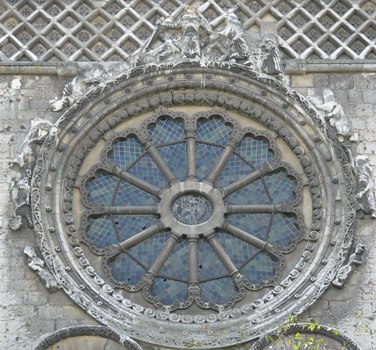
the inevitable change that accompanies the normal cyclical movement placed upon us by time itself. Not only is there growth, maturing, and eventual death, but within each of these there are smaller cycles of growth, coming to fruition, and decay or letting go.
Perhaps this aspect is worth considering especially when we struggle to face situations that are even beyond the hands of Fortuna, but rather more in the hands of the Fates whose spindle not only spins the golden thread (or silver chord) of life, but also apportions lots and, inevitably, eventually cuts the thread of life at some point.
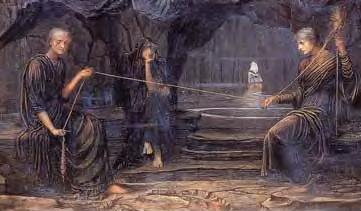
There are, then, three distinct aspects that we are lead to consider in the workings of the wheel: the weavings appointed in the personal and social fabric of our individual lives; the vicissitudes of life's random events; and the cyclical movement of the wheel's turning, season by season, day by day. And our own individual response to the way in which these permeate our heart, our thinking and our will-force or acts.
Personal response
Perhaps it is in part this last – how we respond to the events in which we are placed – that shows differences between the human figure atop the wheel; the over-ambitiousness of the ass that strives and struggles to gain to a position above its abilities no matter what; and the monkey who without effort allows itself to be flung from the rim's inevitable movement.
Platform as stability
If we look again carefully at the card, there is something different about the position atop the Wheel: it appears to have a platform upon which the individual is seated.
If there is indeed a platform, it may be that this also stands, though located atop, as untouched by the Wheel's rim and its constant motion.
Such equipoise requires a sense of inner tranquillity, acceptance and equanimity, together with a certain control of thoughts and action, perseverance, as well as tolerance to what may be heading one's way and impartiality to its provenance (6). These, of course, also form part and parcel of some of the virtues to be cultivated by each of us as we meet destiny's onslaughts - and virtues, I would suggest, would have been implied in reflections on this as well as other card images.
The Ass and the Monkey
Perhaps at first surprisingly, there remains clarity and consistency that the two figures on the sides of the TdM Wheels are of Ass (or donkey) and of Monkey, with the former ascending, and the latter in the descending (or 'falling') position.
For many years I considered that such must have been of symbolic significance, yet no tarot book (nor other materials I had read) satisfactorily addressed this aspect. It is only in the re-writing of this book from which this article forms, in large part, an extract, that the specific details emerged. I mention this as there are still numerous details to tarot that have yet to be unveiled which only careful attention to detail, familiarity with early decks, and an increased understanding of symbolic representations in use inlate mediæval and renaissance imagery will bring to light.
For myself, it was not 'just' that these animals are consistent across various TdMs, but also that they are evident if one looks very closely at the 15th century Visconti decks: not the main image, but the gold-leaf bears lines that makes of the ascending figure an ass, and the descending one have a monkey's tail (7) (see below).
So what of these?
I suspect that this is one of those 'transformations' of human-to-symbolic animal that was ever-so 'natural' to those of the times, and that the ascent as Ass and fall as monkey were far more commonly understood than they today are.
According to the mediæval Physiologus, the devil was 'simia Dei' (God's monkey), and the monkey was associated with humanity's fall and continued to represent human sin into the Middle Ages (8).
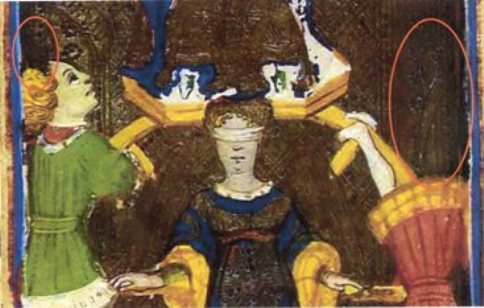
As for the Ass, it probably derives from a joke that confounds 'Bisodia' as the name at times used for Christ's Ass but also infers fantasy (or more properly speaking phantasm). The Ass can also therefore be seen to represent false aspirations (the Ass upon which Christ sat is not to be confused with the Christ).
So we have, on the one side, the striving ascent beyond the natural position of the person (ass) in question; and on the other the fall (as monkey) by his own disobedience to divine precept. Yet each can also find itself in a position inappropriate to it by the whims of Fortuna!
Notes
1 - or, more aptly, 'Consolation of Philosophia', as Philosophy is therein allegorised.
2 - Here I would, following the works of others, suggest that especially the neo-platonist Proclus and Plotinus are of influence, more so than Plato and Aristotle.
3 - To be sure, even the heavens have apparent fluctuations when specifically considering the planets, for which epicycles were invoked as explanation by the Ancients. Still, these were meant to explain how apparent change was in fact due to the circular constancy akin to 'wheels within wheels'.
4 - B. Lonergan, Method in Theology, 1971, p 66.
5 - though here a reminder that these meanderings was, again, explained by the epicycles of circles within circles. See, for example, the Ptolemaïc view.
6 - Steiner also talks of these six qualities, in a different context, in his early work Knowledge of the Higher Worlds.
7 - to be sure, other similar details are also included on that card, such as ears also appearing on the crowned figure atop, and Fortuna being winged.
8 - Cf, for example, Corbey's Metaphysics of Apes, p.66.
© Jean-Michel David
On the autor, Honorary Partner of the Cultural Association Le Tarot, please see Jean-Michel David.